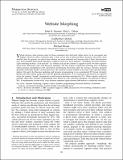Website Morphing
Author(s)
Hauser, John R.; Urban, Glen L.; Liberali, Guilherme; Braun, Michael
DownloadHauser_Website Morphing.PDF (4.280Mb)
PUBLISHER_POLICY
Publisher Policy
Article is made available in accordance with the publisher's policy and may be subject to US copyright law. Please refer to the publisher's site for terms of use.
Terms of use
Metadata
Show full item recordAbstract
Virtual advisors often increase sales for those customers who find such online advice to be convenient and helpful. However, other customers take a more active role in their purchase decisions and prefer more detailed data. In general, we expect that websites are more preferred and increase sales if their characteristics (e.g., more detailed data) match customers' cognitive styles (e.g., more analytic). "Morphing" involves automatically matching the basic "look and feel" of a website, not just the content, to cognitive styles. We infer cognitive styles from clickstream data with Bayesian updating. We then balance exploration (learning how morphing affects purchase probabilities) with exploitation (maximizing short-term sales) by solving a dynamic program (partially observable Markov decision process). The solution is made feasible in real time with expected Gittins indices. We apply the Bayesian updating and dynamic programming to an experimental BT Group (formerly British Telecom) website using data from 835 priming respondents. If we had perfect information on cognitive styles, the optimal "morph" assignments would increase purchase intentions by 21%. When cognitive styles are partially observable, dynamic programming does almost as well—purchase intentions can increase by almost 20%. If implemented system-wide, such increases represent approximately $80 million in additional revenue.
Date issued
2009-03Department
Sloan School of ManagementJournal
Marketing Science
Publisher
Institute for Operations Research and the Management Sciences
Citation
Hauser, John R. et al. “Website Morphing.” MARKETING SCIENCE 28.2 (2009): 202-223. © 2009 INFORMS
Version: Final published version
ISSN
0732-2399
1526-548X
Keywords
telecommunications, website design, automated marketing, clickstream analysis, Bayesian methods, dynamic programming, cognitive styles, internet marketing